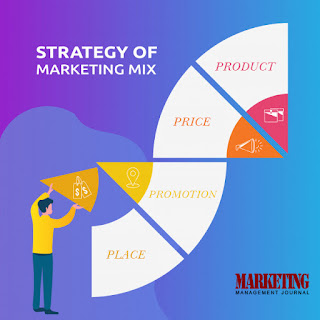Marketing Mix (4 P's)
The Marketing mix is a tool using in marketing products. The marketing mix is often crucial when determining a product or brand's unique selling point and is often synonymous with the four P's.
4 P's can be illustrated as price, product, promotion, and place. in recent times, however, the four Ps have been expanded to the seven Ps or replaced by the four Cs.
The term Marketing mix was coined in an article written by Neil Borden called “The Concept of the Marketing Mix.” He started teaching the term after he learned about if from an associate, James Culliton, who in 1948 described the role of the marketing manager as a "mixer of ingredients"; one who sometimes follows recipes prepared by others, sometimes prepares his own recipe as he goes along, sometimes adapts a recipe from immediately available ingredients, and at other times invents new ingredients no one else has tried.
Four Ps: the producer-oriented model
The marketer, E. Jerome McCarthy, proposed a four Ps classification in 1960, which has since been used by marketers throughout the world.

Product - A product is seen as an item that satisfies what a consumer needs or wants. It is a tangible good or an intangible service. Intangible products are service based like the tourism industry, the hotel industry, and the financial industry. Tangible products are those that have an independent physical existence. Typical examples of mass-produced, tangible objects are the motor car and the disposable razor. A less obvious but ubiquitous mass-produced service is a computer operating system.
Every product is subject to a life-cycle including a growth phase followed by a maturity phase and finally an eventual period of decline as sales fall. Marketers must do careful research on how long the life cycle of the product they are marketing is likely to be and focus their attention on different challenges that arise as the product moves through each stage.
The marketer must also consider the product mix. Marketers can expand the current product mix by increasing a certain product line's depth or by increasing the number of product lines. Marketers should consider how to position the product, how to exploit the brand, how to exploit the company's resources, and how to configure the product mix so that each product complements the other. The marketer must also consider product development strategies.
Price – The price is the amount a customer pays for the product. The price is very important as it determines the company's profit and hence, survival. Adjusting the price has a profound impact on the marketing strategy, and depending on the price elasticity of the product, often; it will affect the demand and sales as well. The marketer should set a price that complements the other elements of the marketing mix.
When setting a price, the marketer must be aware of the customer's perceived value for the product. Three basic pricing strategies are market skimming pricing, marketing penetration pricing, and neutral pricing. The 'reference value' (where the consumer refers to the prices of competing products) and the 'differential value' (the consumer's view of this product's attributes versus the attributes of other products) must be taken into account.
Promotion - represents all of the methods of communication that a marketer may use to provide information to different parties about the product. The promotion comprises elements such as advertising, public relations, personal selling, and sales promotion.
Advertising covers any communication that is paid for, from cinema commercials, radio and Internet advertisements through print media and billboards. Public relations is where the communication is not directly paid for and includes press releases, sponsorship deals, exhibitions, conferences, seminars, or trade fairs and events. Word-of-mouth is any apparently informal communication about the product by ordinary individuals, satisfied customers, or people specifically engaged to create word of mouth momentum. Sales staff often plays an important role in word of mouth and public relations (see 'product' above).
Place - refers to providing the product at a place that is convenient for consumers to access. The place is synonymous with distribution. Various strategies such as intensive distribution, selective distribution, exclusive distribution, and franchising can be used by the marketer to complement the other aspects of the marketing mix.
The 'seven Ps' refers to the already mentioned four Ps, plus 'physical evidence', 'people', and 'process'. 'Physical evidence' refers to elements within the store. The storefront, the uniforms employees wear, signboards, etc. 'People' refers to the employees of the organization with whom customers come into contact. 'Process' refers to the processes and systems within the organization that affects its marketing process. These latter three factors are not cited nearly as often as the first four outlined in-depth above.
Four Cs: the consumer-oriented model
Robert F. Lauterborn proposed a four Cs classification in 1993 which is a more consumer-oriented version of the four Ps that attempts to better fit the movement from mass marketing to niche marketing:
The product part of the four Ps model is replaced by "consumer", shifting the focus to satisfying the consumer needs. Another C replacement for "product" is "capable". By defining offerings as individual capabilities that when combined and focused on a specific industry, create a custom solution rather than pigeon-holing a customer into a product.

Price is replaced by "cost", reflecting the total cost of ownership. Many factors affect the cost, including but not limited to the customer's cost to change or implement the new product or service and the customer's cost for not selecting a competitor's product or service.
Promotion is replaced by "communication", which represents a broader focus than simply promotions. Communications can include advertising, public relations, personal selling, viral advertising, and any form of communication between the firm and the consumer.
The place is replaced by "convenience". With the rise of the internet and hybrid models of purchasing, Place is becoming less relevant. Convenience takes into account the ease of buying the product, finding the product, finding information about the product, and several other factors.









.gif)
